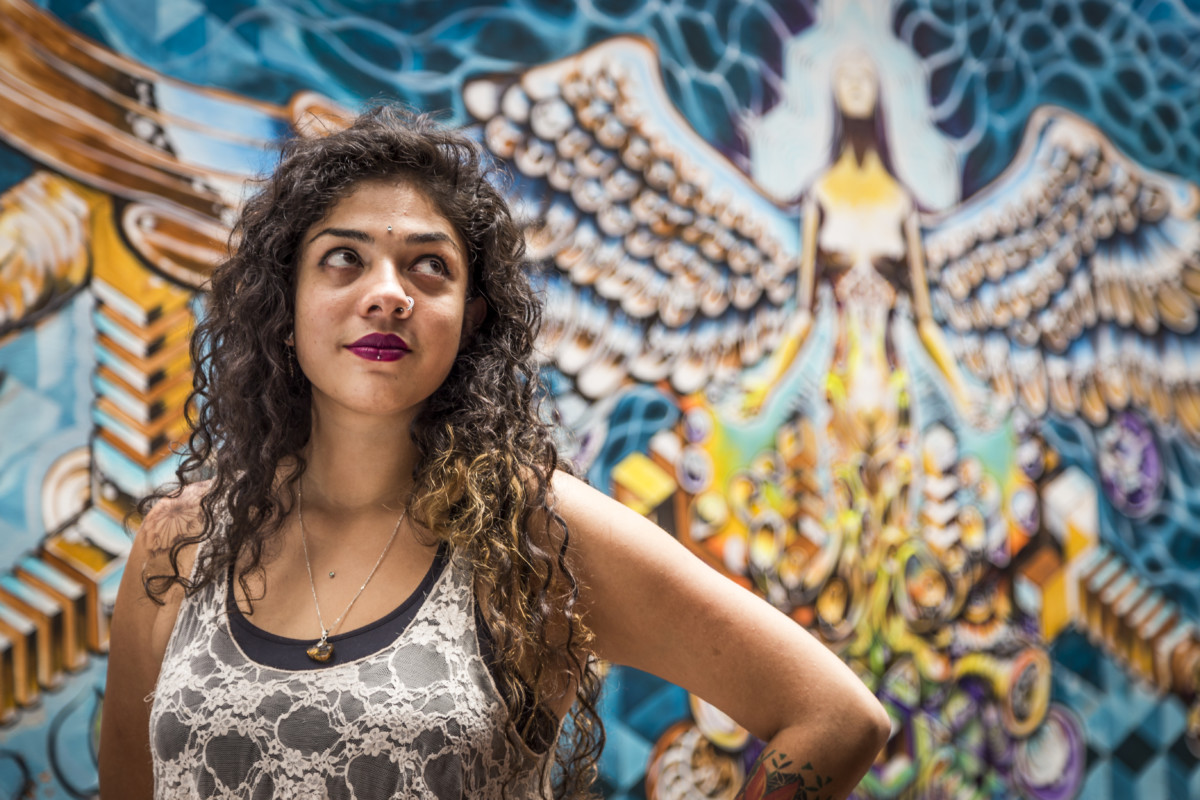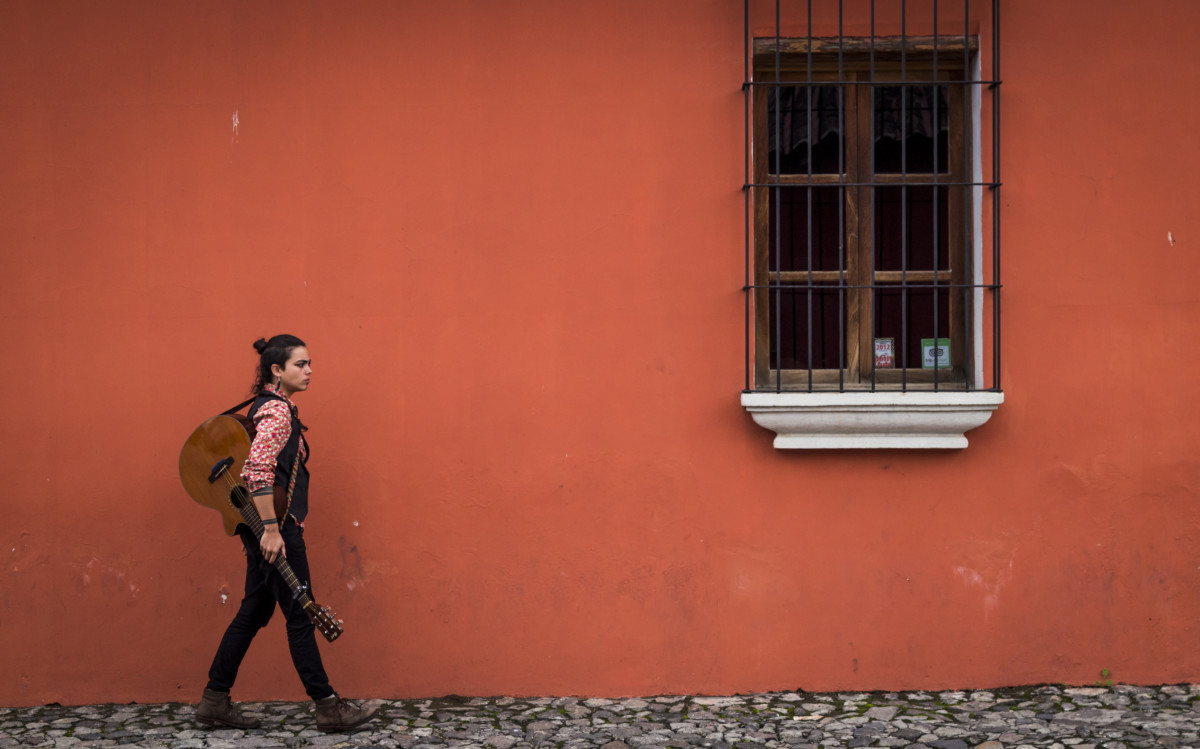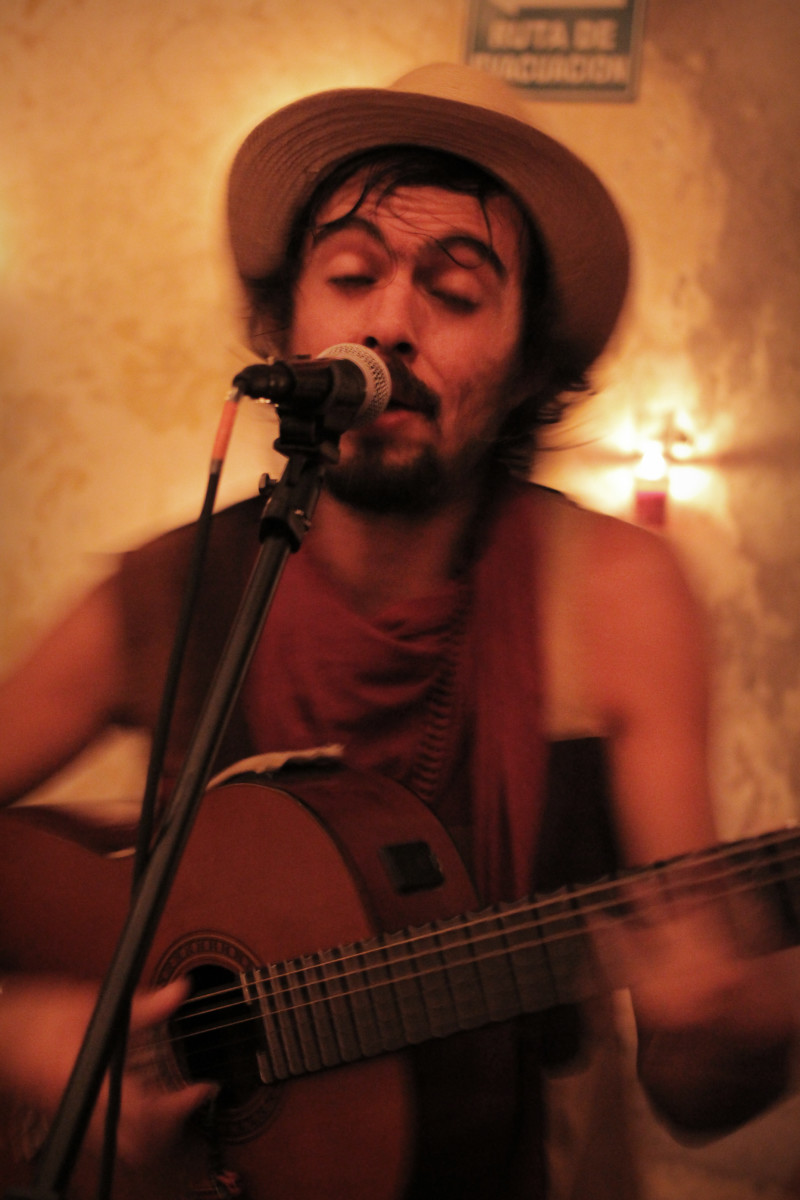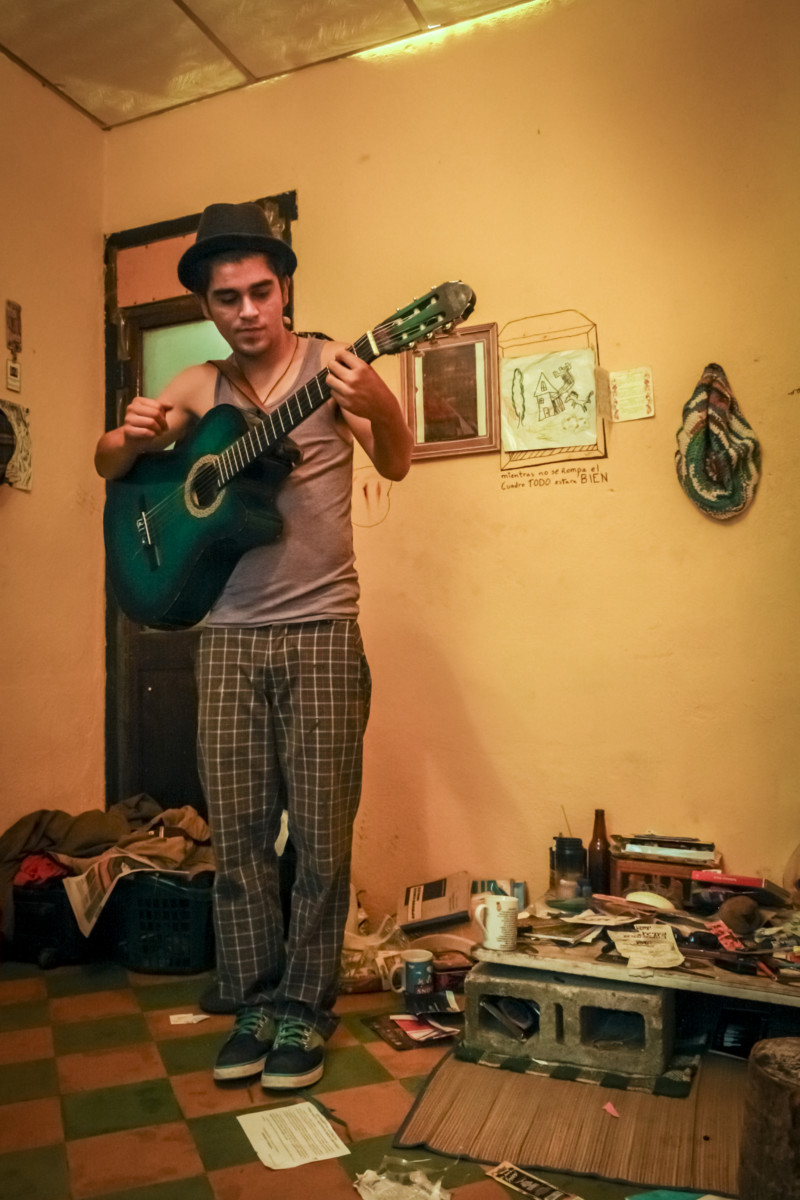Image taken by Oscar Villeda.
“Have you heard this band, Calimosho?” my friend Gerry Flores said. “They’re like a mix between Tom Waits, Manu Chao, and Celso Piña.”
“Yeah right,” I said.
“Trust me. They play folk, country, blues and cumbia,” he said.
Gerry’s band, Hermaano was opening for Calimosho. I had attended the show for solidarity but stayed because my morbid curiosity couldn’t imagine such a band.
In 2011, I was working as a cultural journalist in Guatemala City. The local music scene was still a timid movement. There were only a handful of bars for aspiring musicians and just one record label. Back then bands playing originals were still considered irksome. That same year, Calimosho’s lead singer, El Gringo Moko, recorded his first solo album: Música Camionetera, a sassy, inventive and unexpected mix between folk, country and acoustic blues with Balkan music, gypsy folk, swing, cumbia and rancheras. He was singing about narcos, Guatemalan politics, riding camionetas and crossing the border. Sure enough, Calimosho – El Gringo’s band – was as if Tom Waits and Manu Chao had collaborated.
Bany Ajpú joined El Gringo as his backup singer, often delivering political messages while he sang. Calimosho’s rhythmic section was in charge of La Quetzalterca and Marco. La Quetzalterca scrapped an empty bucket of paint with a piece of wire to emulate a güiro, and Marco played a handmade bass made of an(other) empty bucket, a broomstick and plucked a thick lasso as if it were a double bass. Calimosho was nothing like I heard before, in Guatemala or elsewhere. They infected the crowd with their rhythmic slur; they turned Chocolate Jesus into an infectious, musical fiambre.
“…And please don’t vote for Otto Pérez,” Bany said at the end of the show. “Don’t vote for a genocide, vote for the cumbia.” The crowd cheered.
I ended up buying Gringo’s CD and approached the band after the show to schedule an interview.
The sound of a Guatemalan chicken bus is unmistakable. Camionetas, as we call them, stomp like old ships. They march like aging elephants, they hiss, totter, fumble and fart. They’re the steampunk beasts of Guatemalan traffic. On a bad day you can get robbed at gunpoint; on most days you can get serenaded. Many of Guatemala’s most important current singers started up on a chicken bus, playing boleros and passing the hat.
Many of Guatemala’s most important current singers started up on a chicken bus, playing boleros and passing the hat.
“It’s a great source of income, if you’re just starting up,” Ishto Juevez said. “Up to 70 dollars a day.”
Ishto is one of the most important and active chicken bus singers in the country, with six solo records under his belt. Although it’s been some time since he’s stepped out of the buses, he learned to tame the crowd and conjure cumbias for a few bills. A mix between Eugene Hutz, The Mad Hatter, Jack Sparrow and Cantinflas, Ishto is an experienced backpacker, producer and street performer. His style – a mix between cumbia, blues, swing and Latin folk – is the result of years of musical exchange with other chicken bus singers across Latin America and European gypsies.
Fresh out of high school in 2002, Ishto packed his guitar and left for South America. When he got to Colombia he was introduced to some of the legendary cumbia singers: Toto La Momposina, Petrona Martínez and Alé Kumá. “There I learned that cumbia is the musical element that glues most Latin American music,” he said, downing a large glass of lemonade.
After three years singing up and down Latin America, Ishto came back to Guatemala with Mamalapacha, his first cumbia band that he had put together with fellow travelers. They spent the next two years recording their debut album. When Mamalapacha presented Maltiyoox Mama in 2007, up to five hundred people gathered to dance to their Latin feast. But two months later the band split. Ishto took the two songs he had written for the band, recorded a few more, completed his first solo album and left for Europe.
In the meantime, other chicken bus singers rattled locally.
In 2009, Guatemala City’s Town Hall began deep renovations on La Sexta Avenida. They relocated street vendors, renewed worn down buildings and converted the hectic avenue into a passerby’s exclusive track. Pretty soon mimes, break-dancers, live painters and many, many singers took La Sexta. There, among the crowd, I first listened to singers like Raysa Morales Devorah Rahel and Junio Jocol.
“Us women, we also guerreamos,” said Raysa. Gue-rre-ar as Raysa calls it, means “to fight” or “to war,” to sing your income out in the streets. “I got from Guatemala, to California guerreando,” she said with a candid smile that pushed aside all the piercings and jewels on her brown face.
Among the most interesting female chicken bus singers in Guatemala are Pat’za, Devorah Rahel, Maf Ë Tulà and Raysa. Housewife-turned-singer Devorah has the sweet delicacy of a goldfinch but the acute potency of an experienced Violeta Parra. After years singing in the streets, Devorah has performed all over the country. She just recently released her first solo album and has since begun working as a cultural manager and touring with local cumbia acts.
Raysa has a delicate and thunderous voice, soothing and equally devastating. Her music evokes old bolero singers like Pedro Infante and Los Panchos, however quickened and seasoned by Latin fok and gypsy swing. Raysa just released her first album: Azul Bonito and will spend the following months touring Central America.
Pat’za was among the first female street acts to gain notoriety in Guatemala. She frequented local bars and restaurants back when covers were still a must, but her snappy songs were well received among the local artistic community. Raised on Patty Bravo, Joan Baez and Dolly Parton, her quick and raspy vibrato is a soothing, sour rain. She can be a delicate crooner, or embody a ferocious gypsy singer. She released Criterio Amplio in 2010 to wide acclaim; it was a delicious mix of trova, gypsy swing and Latin folk. In time, she was picked by Zona Música, the first musical showcase in Guatemala ever to be funded by an international institution. She introduced El Gringo to some of the bars she played at and began singing and recording alongside Costa Rican singer Maf É Tulà, who later joined Ishto Juevez as part of his live band.
“How did you end up in Guatemala?” I asked Maf Ë Tulà after a live session recording for Guatemalan online magazine esQuisses.
“Thanks to the music,” she said.
Maf has been living in between Guatemala and Costa Rice for almost ten years. Currently situated in San José, she sung her way through Central America, Mexico, Cuba and Argentina. That constant movement in between countries broadened her musical background. She grew up listening to reggae and bossa, and was influenced by Latin folk, country, blues, gypsy swing, cumbia and world music. If you ever hear Maf, you feel as if you have walked into a gypsy cabaret, or hitchhiked a cumbia circus band. She’s currently back in Costa Rice recording a new album.
The Hitchhiker’s Guide to the street singing in Latin America, according to Maf and Raysa, says: cumbia for the young people, boleros for the elders.
All of us have sung in great stages, but people in camionetas are the most demanding crowd; you only have a few seconds to convince them that you’re any good.
According to Maf, “All of us have sung in great stages, but people in camionetas are the most demanding crowd; you only have a few seconds to convince them that you’re any good.”
While in Denmark, Ishto Juevez recorded one more solo album. Unlike its predecessors, most of the songs were written in English. In Copenhagen, Ishto enjoyed the many cultural goods of the Danish capital. He toured locally, organized festivals and studied swing, delta blues, gypsy jazz, Balkan and klezmer music at local libraries.
“Why did you begin playing to folk? Didn’t they like your music?” I asked Ishto.
“They just don’t speak Spanish,” he smiled.
Ishto spent the next few years in between Mexico, Denmark and Germany. When he finally got back to Guatemala, 2011, the local musical scene had changed. He found a steady job singing three times a week at Café Nosé in Antigua, applied for the second edition for Zona Música. Previously known as a Latin singer, Ishto swanked his gypsy swing, funk and blues to make him one of the most popular acts in town, along with Calimosho.
“At first I didn’t like El Gringo,” he said and grinned at me, flashing a star-shaped ornament lodged onto one of his teeth. “People kept telling me that our music was similar; I couldn’t stand him.”
However, soon after Ishto put together the La Torilla collective with other gypsy singers such as Maf, Pat’za and Calimosho.
“Eventually I appreciated their energy and product,” he said. “There was some real talent there. That guy (El Gringo) is a really great songwriter.”
“That guy,” scrawny, slightly hunched, and under-slept-looking, greeted me at Parque Morazán, just a few days after the show where I had met him and Calimosho. He told me to follow him to the house they lived in. Inside there were ragged clothes on the floor, empty bottles of beer, avocados, handmade kazoos and an old Playboy Magazine from the seventies. The sour stench of cheap marijuana filled the air.
“This is our first interview, I’m kind of nervous,” Bany smiled while Quetzalterca poured Gallo beer into a plastic pitcher.
“Sorry, guys,” she said. “We don’t have any cups, we’re just going to have to pass this around.”
Originally from California but raised in Ohio, El Gringo grew up listening to country music. When he was eighteen, he fled the country, spent eight months in Mexico and finally reached Guatemala where he found a part-time job teaching English at a local orphanage. El Gringo began singing because he needed the money, and met Bany along the way.
“We were very different, El Gringo and I,” Bany said while rolling a joint. “When I met him, I was playing reggae and cumbia,”
“And I was mostly playing folk and blues,” El Gringo said. “But I found out that the folk’s rhythm, its brinconcito, really goes along with the cumbia.”
With that new sound, El Gringo recorded his first album, which included songs like “Narquita Linda” about a drug dealer friend and “Tip Top” about Guatemala City’s glue sniffers. While touring, El Gringo met the rest of the band.
The band sounded rusty, dirty, as if smothered by weed and lubricated with aged whiskey. Calimosho had the grungy allure of an old train, of a Guatemalan camioneta.
I asked the band to grab their instruments for a quick photo-shoot. El Gringo and Bany stroked their guitars at unison, the rest followed suit. A juicy, gritty version of “Ain’t No Sunshine/I Put a Spell on You” crept out of El Gringo’s pipes. The band sounded rusty, dirty, as if smothered by weed and lubricated with aged whiskey. Calimosho had the grungy allure of an old train, of a Guatemalan camioneta.
“Vote for the cumbia!” Bany said, and the song faded.
A few months after Calimosho recorded their debut album at Ishto’s home studio. Some time later the band parted ways. In 2013 Bany released his first solo album and El Gringo went back to California. In late 2014 he released Guatermalan Watermelon, an album he recorded a few days before leaving the country that still captures that delectable sound he matured while traveling the country. He’s now studying geology.
One year after El Gringo left, Ishto Juevez released the concept album ELE Migrante, one of the finest and most inventive musical records ever produced in Guatemala. This wonderful work includes nine songs that deal with the migrant experience, mojado tales, and what it’s like to backpack through Latin America. ELE Migrante is a delicious musical carnival made of acoustic funks, reggaes, spoken-word, Latin folk, gypsy swing and, of course, cumbia.
Ishto toured Guatemala, Costa Rica and the United States for over a year to promote the record. Quickly ELE Migrante positioned Ishto as one of the most beloved singers in the country. Often Ishto’s shows get packed; he has been called to important local festivals and opened for Café Tacvba and Kevin Johansen. He is the finest example of the success the chicken bus singers have gained.
Others have been featured on film soundtracks; some often play at chic, upper-class restaurants. A new circuit of local songwriters called Aves Raras, sponsored by Spanish institutions, has invited Devorah, Pat’za and Raysa, among others. Even fellow Guatemalan singer – and Latin Grammy winner – Gaby Moreno has invited Ishto, Pat’za and Devorah to join her onstage alongside great international singers such as Natalia LaFourcarde, Ximena Sariñana and Llewyn Davis/Poe Dameron/Apocalypse himself, Oscar Isaac.
“I’m all about making music for the people, for the streets” Ishto said. “Being out in the streets has made me more sympathetic. There’s simplicity and humility there, the type you won’t get to know in the academia.”
Ishto stopped talking and looked up, as if neatly putting together his next story.
“Years ago, after spending a miserable night in Peru I went out to nearby town’s plaza to sing. It was almost empty, at first I only got a couple of bills,” he said. “However, Peru was playing Chile that day – there’s a longstanding football rivalry between the two countries. At the end Peru won and in a matter of minutes there were hundreds of people celebrating at the plaza. At the end of that night I had enough money to get by, and met the people I traveled with for the forthcoming years,” he smiled. “The street is magical.”
That’s Guatemala City: gnarly, chaotic and dangerous — with the thickest, grittiest cumbias you can find.
There are up to fifteen murders a day in Guatemala City. In 2015 alone up to 62 bus drivers were murdered while on duty. Just two blocks away from where I interviewed Ishto and Raysa, eighteen years ago the Roman Catholic Bishop Juan Gerardi was bludgeoned to death for the publication of a 300-hundred page report on the victims of the Guatemalan Civil War.
That’s Guatemala City: gnarly, chaotic and dangerous. However, among the everyday violence and the daily tedium, inside the camionetas’ discomfort and overall insecurity, there are spicy ranchers, dreamy boleros, poetic trovas and the thickest, grittiest cumbias you can find.
Although the Guatemalan Chicken Bus Gypsy Caravan was much more of a coincidence than an actual movement, its singers are now among the most respected of the country. The new Guatemalan music tradition was brought up on the streets of Latin America, by intrepid walkers and the cumbia.






